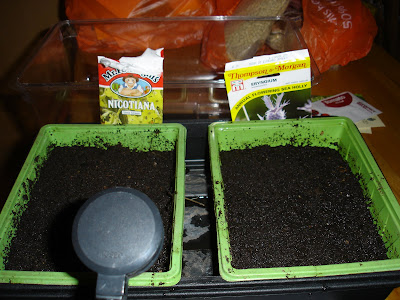Another round of optimistic seed-sowing today. I've tried sunflowers many times - from seed, from small plants and from larger pants in pots. I usually go for a smaller, pretty variety, but each time the plants have been entirely devoured by slugs which is very annoying. I decided to have another go this year - with a variety called "Titan" which is supposed to be very tall and strong. I also sowed some more sweet peas - a large-flowered variety which was free with Gardeners' World magazine, and some nasturtiums - Empress of India - which I found in my spare seed box. I don't know how old the nasturtium seeds were but they were firm and plump, so I thought I'd give them a go. I hope the small amount of mould on the outside of the seeds isn't a problem.
These seeds were all placed into the mini-greenhouse outside. I sowed two other seeds in my heated propagator - some Eryngium leavenworthii - a type of sea holly, and Nicotiana Lime Green. The propagator is kept on my kitchen windowsill.
(The round thing in the picture is the plug of the propagator - to remind me that the nicotiana is at the plug end of the propagator)
I will let you know how all these seeds work out - but don't hold your breath - I don't have a good record with seeds.
Also today, I planted out some plants grown in pots. I planted three pyracantha "Orange Glow" along the ugly wall at the end of the garden. Hopefully, these will grow into a dense evergreen thorny hedge, with white flowers and orange berries to feed the birds in winter. The soil here is quite poor, so for the first time ever, I used some of my home-made compost to improve the soil in the planting area.

This afternoon, I went out to buy some lavenders to replace the lavender hedge. I didn't find them, but I did find some lovely plants which I bought on impulse.

I've bought fennel and pulmonaria before only to have them murdered by slugs. These are quite big plants grown in "hairy" pots, which you can plant direct into the ground without disturbing the roots, which grow through the pots into the soil. This makes them stronger than other plants (and you don't have to dispose of a plastic pot, so it's more environmentally friendly). Hopefully they will succeed where other pants have failed. The fennel is in the left hand bed, next to the rose arch. The pulmonaria are in the front garden. I used my home-made compost again to improve the soil.
The two plants at the back are more hellebore oriental hybrids. They are both quite different to the others I have. I will probably grow them in pots on the patio.
The plants in the front garden, which is planted for spring, are looking really good now. The Daphne Bholua "Jacqueline Postill" is fully out, and the scent carries for several yards down the street. I am often asked what it is by passers by. It is next to the hedgehog holly, ilex aquifolium ferox argentea which is very prickly and variegated gold and green.
I have one flower on the camellia in the front garden - there are many more buds. I hope the frost is over so that they can open safely. This is Camellia "Jury's Yellow" Which is more cream than yellow but very pretty.



























